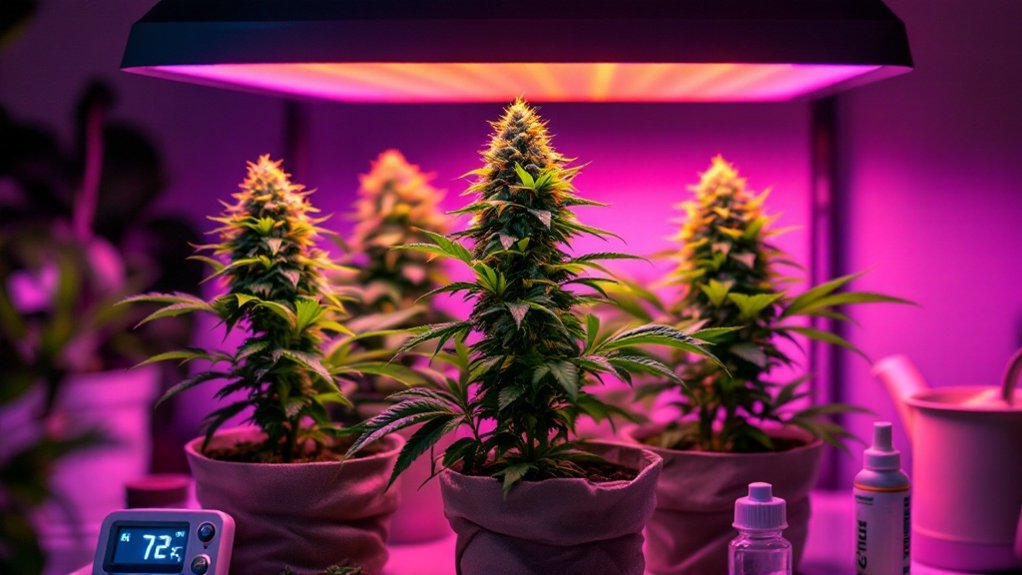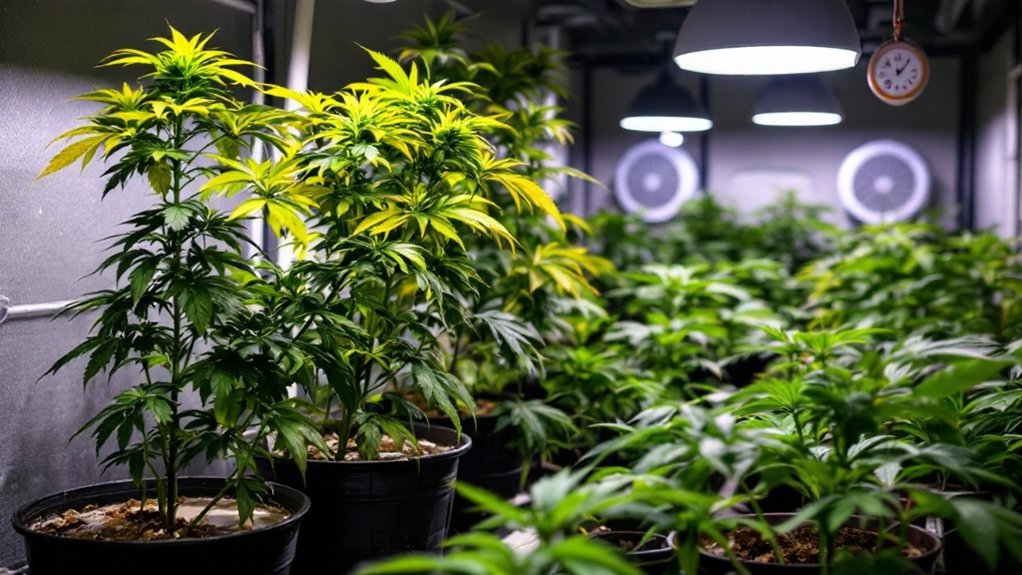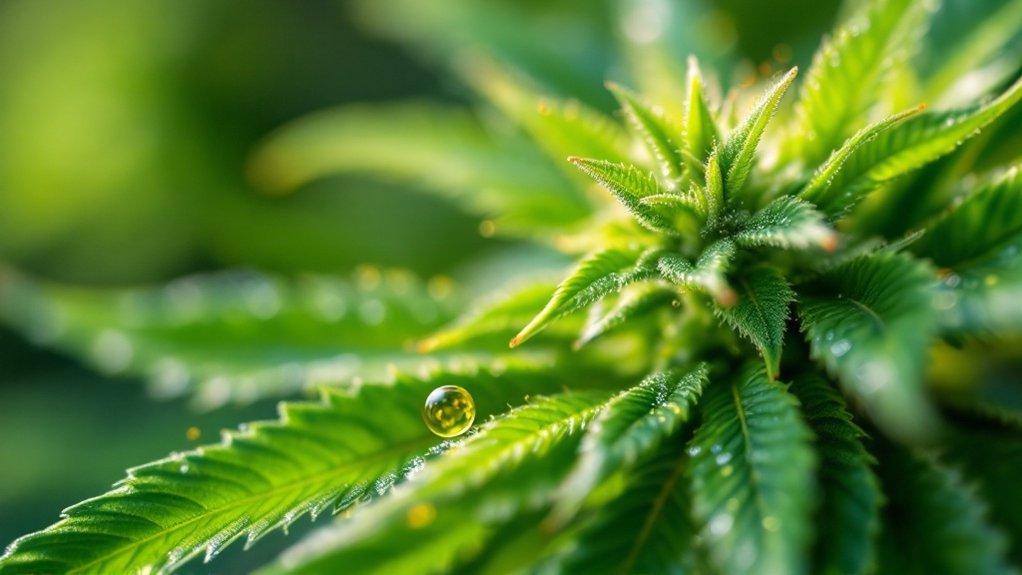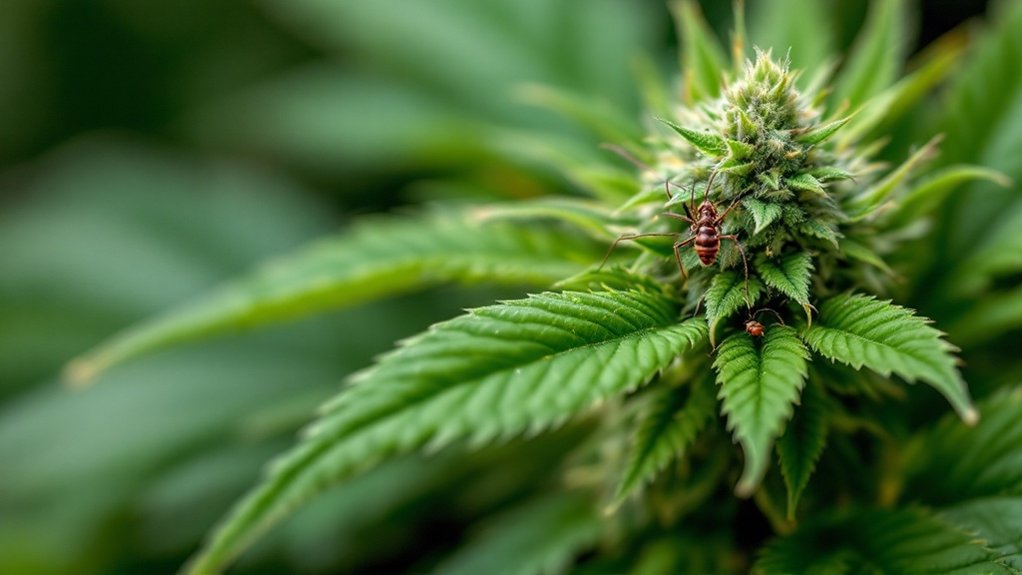Growing autoflowers indoors requires maintaining an 18/6 or 20/4 light schedule with lights positioned about 45 centimeters (18 inches) above plants. Keep temperatures between 68-77°F (20-25°C) and gradually reduce humidity to 40% during flowering. Autoflowers are sensitive to over-fertilization, so organic nutrients work best while maintaining soil pH between 6.0-6.5. Most varieties mature in 8-10 weeks, with harvest timing determined by milky trichomes and reddish-brown pistils. Proper environmental control ultimately determines yield potential.
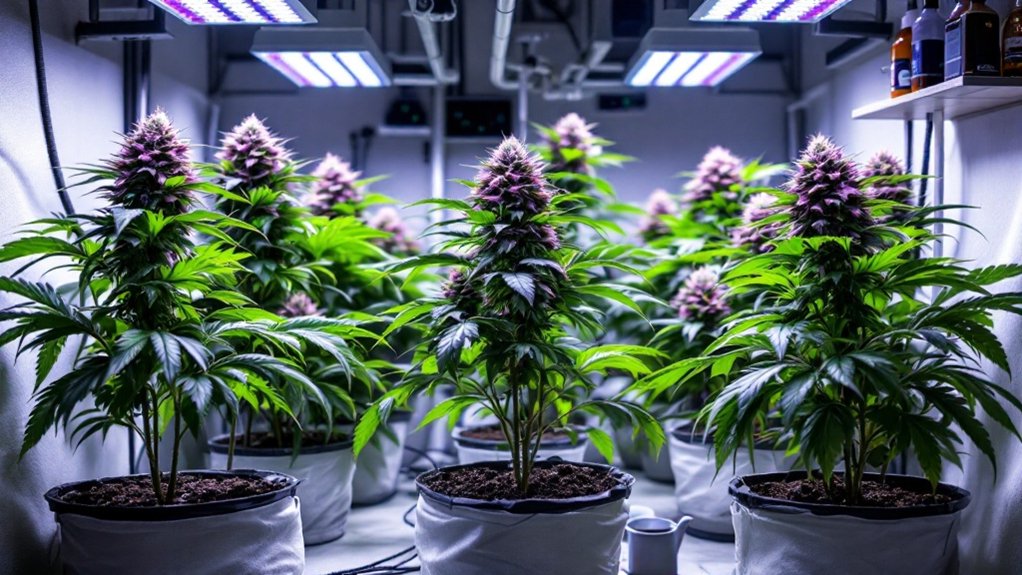
While traditional cannabis cultivation often requires precise light cycle manipulation, autoflowering varieties have revolutionized indoor growing by automatically shifting from vegetative to flowering stages regardless of light schedule. These plants have gained popularity among indoor growers for their quick growing cycle and adaptability to confined spaces. With the integration of automated systems and robotics, cultivators can further streamline their processes for optimal results.
Cultivators can achieve multiple harvests per year with autoflowers, compensating for their typically lower individual yields of 50-250 grams per plant compared to photoperiod varieties.
Light management plays an essential role in maximizing autoflower production. Most successful growers maintain an 18/6 light schedule throughout the entire growing cycle, though some prefer 20 hours of light and 4 hours of darkness. Proper positioning of lights at approximately 18 inches from the plant canopy helps enhance development, with adjustments necessary as plants grow taller.
Environmental control greatly impacts autoflower success. The ideal temperature range falls between 68°F and 77°F (20°C to 25°C), with specific attention required during the flowering stage. During weeks 8-10, maintaining temperatures around 77°F while reducing relative humidity to 40 percent creates ideal conditions for resin production and prevents mold development that could compromise the harvest.
Selecting high-quality seeds from reputable sources like FastBuds represents the foundation of successful cultivation. Growers should consider potency, flavor profiles, and specific growing environment requirements when choosing strains.
Most cultivators utilize the paper towel method for germination, with seeds typically sprouting within 1-3 days when kept in a warm, dark environment.
Careful water management proves essential for autoflowers’ success. During final growth weeks, plants generally require approximately 1.5 liters of water every 24 hours. The flushing phase involves flooding the growing medium with as much water as it can hold.
Autoflowers have limited recovery time from watering mistakes, making proper hydration critical while avoiding both overwatering and underwatering scenarios.
Nutrient requirements evolve throughout the autoflower lifecycle and vary between strains. These plants generally show higher sensitivity to over-fertilization compared to photoperiod varieties, making organic nutrients an excellent choice for their slower release properties. The genetic background of autoflowers from Cannabis Ruderalis contributes to their lower nutrient needs compared to traditional photoperiod plants. Maintaining the soil pH balance between 6.0 and 6.5 is crucial for nutrient uptake and preventing deficiencies.
Growers should cease providing bloom nutrients during the final growth stage to prepare plants for harvest.
Harvest timing requires careful observation. Most autoflowers reach maturity between 8-10 weeks after sprouting. The ideal harvest window occurs when trichomes appear milky in color and pistils develop a reddish-brown hue, signaling peak potency and yield potential.
Frequently Asked Questions
What’s the Best Nutrient Brand for Autoflowers?
Fox Farms Cultivation Nation Trio with Cal-Mag offers balanced nutrition specifically suited for autoflowers’ reduced nutrient needs.
General Hydroponics Flora Trio provides reliable feeding with minimal crystallization issues, while Advanced Nutrients pH Perfect automatically balances pH levels for ideal nutrient uptake.
Jack’s 1-2-3 represents excellent value for budget-conscious growers.
Specialized organic nutrient lines enhance terpene profiles and flavor development, though most brands work well when used at approximately 1/4 strength compared to photoperiod recommendations.
How Often Should I Rotate My Autoflower Plants?
Rotating autoflower plants every 1-3 days provides ideal benefits for most indoor setups.
This practice guarantees even light distribution across all parts of the plant, promoting uniform bud development and stronger stem growth.
During flowering, gentle handling becomes essential to avoid damaging developing buds.
In situations with well-distributed lighting systems or widely spaced plants, rotation becomes less critical as light naturally reaches all sides of the plants.
Can I Clone Autoflowering Cannabis Plants Successfully?
Cloning autoflowering cannabis is technically possible but generally impractical.
Autoflower clones inherit the genetic age of their parent plant, meaning they will flower based on elapsed time rather than size. This biological constraint severely limits their vegetative growth potential, resulting in smaller plants with reduced yields.
Success rates remain considerably lower than with photoperiod varieties, with clones typically reaching only about 80% of the parent’s size.
Most commercial and experienced growers prefer starting autoflowers from seed for best results.
Do Autoflowers Need a Dark Period During Flowering?
Autoflowering cannabis plants do not technically require a dark period to initiate flowering, as they flower based on age rather than photoperiod.
However, research suggests providing 4-6 hours of darkness daily can improve metabolic efficiency, enhance recovery, and potentially increase resin production and overall plant health.
Many experienced growers implement an 18/6 or 20/4 light schedule to balance maximum growth with necessary recovery time, while also reducing energy consumption compared to continuous lighting regimens.
When Is the Best Time to Flush Autoflowering Plants?
The ideal time to flush autoflowering cannabis plants is 1-2 weeks before harvest, when trichomes begin turning from clear to cloudy.
Plants grown in soil generally require a week-long flush, while those in coco or hydro mediums need only 3-5 days.
The timing depends largely on the growing medium and should guarantee trichomes reach their desired maturity after the flush period.
Maintaining water pH between 5.5 and 6.5 during this process is essential.
